#enki and ninmah
Explore tagged Tumblr posts
Text
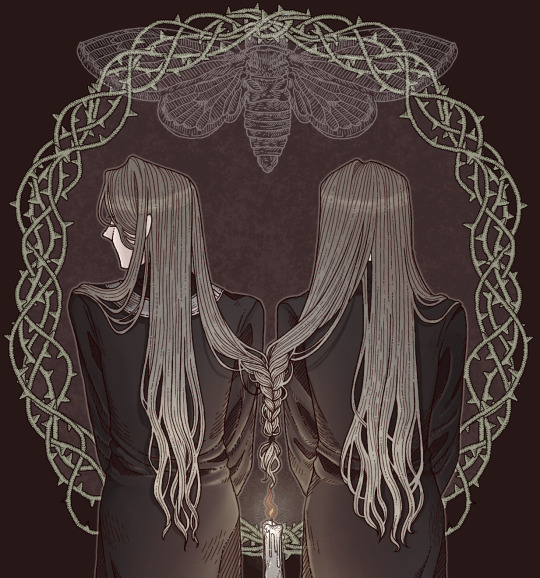
sister
#fear and hunger#enki ankarian#proposing to the fandom that we adopt the idea of her name being ninmah.#my art
2K notes
·
View notes
Text
Enkis backstory is so fascinating to me, I got it out of my system by animating it!!
TW for loud sounds at the end!




And here's a little gif that came out of it!

#digital art#art#fear and hunger#enki ankarian#fear and hunger enki#my art#funger#firealpaca#animation#funger animation#fear and hunger animation#enkistwin#enkis twin sister#NINMAH#ninmah
170 notes
·
View notes
Text





enki scraps
#don't wanna think about how many times i've drawn this guy#enki#enkis sister#ninmah#?#enki ankarian#fear and hunger#funger#funger fanart#fear and hunger enki#nosramus#enkiramus#fear and hunger fanart#fnh
978 notes
·
View notes
Text

the shit twins, the blowjob brothers, sniff and whimper
#saturn sketches#fear and hunger#funger#f&h#enki ankarian#enki's sister#ninmah#nammu is referenced as the sumerian god enki's mother so#and ninmah is one of enki's siblings/spouse?#really depends on the text/story you're reading lol
164 notes
·
View notes
Text

Sketch I made like... months ago of Enki Ankarian and his sister (who I call Ninmah) from Fear & Hunger.
#fanart#illustration#drawing#sketch#traditional art#fear and hunger#art#video game fanart#fear and hunger fanart#fear and hunger art#fear & hunger#fah#fah1#enki fear and hunger#enki ankarian#fear and hunger enki#f&h enki#enki's sister#ninmah ankarian#f&h enki's sister#funger#macabre#macabre art#bugs#bug imagery#bug drawing#I remember I wasn't in a really good frame of mind when I made this#It's still cool though#cesare.png
16 notes
·
View notes
Text

"character study" sketch for something bigger. i hope i'll draw it enki and his twin sister. i imagine her being more dominating and mischievous out of ankarian siblings. enki gets really annoyed by player stopping him from his readings so that may be a result of her getting under his skin all his childhood. that also may not be a thing but a girl can dream i also drew them being full grown adults whoops my bad
#fear and hunger#f&h#enki ankarian#i love @/thanaticist proposition about her name being ninmah#so#ninmah ankarian
103 notes
·
View notes
Text
Funger is so awkward because we know the identities and names of boss characters such as the Crow Mauler and Needles but don't even know the name of impactful characters such as Enki's sister or the Girl.
#i hc that the kid's name is Ninmah meaning 'magnificent queen'#reference to the transformation the kid will (ideally) go through#100% Nilvan's idea#noelle's rambles#fear and hunger#funger#the girl#enki's sister
35 notes
·
View notes
Note
please yap about enki’s sister I beg of you. she’s so cool and so are you
AW thank you!! 🫶
and thanks for letting me indulge in talking about these two!! here's how I see it:

I really like the idea that the ritual fight that was mentioned in Enki's intro wasn't the only time he had to face off against his sister. It was always like that for him and Ninmah. The priests that took them in saw their potential and wanted to know who the superior sibling was.
My headcanon is that not only was Enki physically weaker than her, but emotionally frail as well. That no matter what, he'd always be a close second to his "better" twin. Ninmah was exceptional and obedient. Enki was completely pathetic next to her.
I like to think when they were super young, they did care for each other. But under harsh, abusive conditions from the priests, it further drove a wedge between them. And Enki's frailty warped into his distinct bitterness as to no longer appear as weak - as to compete on the same level as Ninmah.
The ritual fight was an inevitability. A scheme to see who truly was strong enough to live. So when Ninmah spared Enki, it was sort of her way of communicating that she still cared about her brother. Even if they were pitted against one another, even if she seemed unfeeling and unbothered, she still loved him as much as a young (definitely traumatized) girl could in that situation.
So when Enki's given the choice to either accept her mercy or literally backstab her, both are completely plausible. Like yeah he also possibly still loves her. That's his sister and she was always there for him. But on the other hand, after years of cruel reprimanding, he finally had the perfect opportunity to prove his superiority.
Either way, it doesn't end happily at all. If Enki kills Ninmah and raises her as a ghoul, I'm going to assume she won't be completely herself. She's basically dead. The other route is also tragic. Enki accepts defeat and gets chucked into a well. And at the bottom, his resentment festers. Not only towards his whole diocese but also directed at Ninmah. Because if she did truly love him, why did she not rescue him? (In truth, she would've also been doubly punished, let's be real.)
Assuming they're both alive, I'm entirely convinced that they haven't spoken to each other in over a decade. Enki's probably got a LOT of indignation for his old order and, by extension, Ninmah. And Ninmah acknowledges that he's moved on. Maybe it's best they never see each other.
No wonder Enki is such a big hater. He was one of the few people born into this world with someone and yet he still ended up abandoned and alone. :,)
anywayzz that was very rambly and very sad. but did you know bc enki is green and ninmah’s red this means theyre mario and luigi coded

#this is so long im so sorry#back to goofy art#fear and hunger#funger#enki ankarian#enkis sister#cw implied child abuse#corns art tag :0#corn ask :^]#btw again this is like…… super fanficy and was kinda my theory as to why enki was the way he is#totally feel free to just ignore this
133 notes
·
View notes
Note
would you be able to talk more about gender and sexuality in the hebrew bible/ancient world? particularly the idea of there not being a two-sex system, and us projecting contemporary ideas onto it as violence. and is there anywhere we can read more about this?
the two-sex system is a relatively new way to negotiate and essentialize sexual difference. in it, there is male and there is female, two distinct categories with ontological grippage and no spill-over (this is hegemonic but, of course, a construct). we can think of the two-sex model as a horizontal one, with one sex besides its opposite. the ancient world, however, negotiated sexual difference in a one-sex system. there was male, in the hebrew bible, adam, and then there was a kind of non-male. or a lesser-male. female was not a distinct ontic identity but a deviation, a slippage, from the form. think of the one-sex model as a vertical one: male on top, everything else (queer bodies, matrixial ones, dis-eased, etc.) below it. understanding the one-sex model with our two-sex framework is difficult. this ancient world allowed for vertical movement (upwards and downwards) on sexual differentiation. it allowed for non-essentialist sex-talk. it allowed for instability. it did not allow, however, for terms we might use today like 'hetero' and 'homo'—these presuppose an opposite sex that the ancient world lacked.
laqueur's making sex is the book that first tracked this change in sex-systems. now, any theoretical book on the ancient world and its sensoriums, its bodies, its orifices, etc., will concede, or at least be self-conscious of, the fact that if we bring two-sexes into the ane, we are colonizing it (and all colonization is violence). primary texts like enki and ninmah and, of course, j-source genesis tell us much about the one-sex model. more theoretical contemporary works like neumann's handbook on senses, sonik's handbook on emotions, and graybill's work on queer prophets—these also work hard to step into the one-sex model without colonization
69 notes
·
View notes
Text
Namma/Nammu
𒀭𒇉
Sumerian Goddess, primarily from the city of Eridu
Mother of the Gods. Creator of Mankind, specifically in Eridu, elsewhere this role went to Nintur or Ninmah
—How to use internet archive link
🔵 Information
From Gods Demons & Symbols by Black [Internet Archive Link]
"Nammu was a goddess who was considered, in some traditions, to have given birth to An (heaven) and Ki (earth) and to many more of the more ancient gods. Especially she was regarded as the mother of Enki. She came to be thought of as one of the mother goddesses. Her name is written with the same sign as engur, a synonym of abzu, and it is probable that she was originally a personification of the subterranean ocean." [p134]
Dictionary of Ancient Near Eastern Mythology by Leick [Internet Archive Link]
Her name is usually written with the sign engur which was also used to write Apsu. In ancient times she personified the Apsu as the source of water and hence fertility in lower Mesopotamia. She may well have been worshipped in Eridu before Enki, who took over most of her prerogatives and functions. Significantly he was called the son of Nammu. In spite of her decline following the superiority of Enki, during the Neo-Sumerian period, at least at Ur, she was still considered important enough to have statues commissioned in her honour and she also features in the name of the famous king Ur-nammu. In mythology, Nammu appears as the primeval Mother-goddess in Enki and Ninmah who 'has given birth to the great gods'. She has the idea of creating mankind as a help for the gods and it is she who goes to wake her son Enki, asleep in the Apsu, that he may set the process going. [p 124]
Handbook of Gods & Goddess of the Ancient Near East [Google Books Link]:
"Namma: Sumerian goddess of the primeval, subterranean ocean. In the lexical series Diri the name has a syllabic rendering na-am-ma. In some traditions she was the mother of the sky god An, the earth goddess Ki, and a number of other deities. Enki/ Ea, the god of freshwater and wisdom, was considered her son. In the myth of "Enki and Nin-mah," when the other deities began complaining about how hard they had to work, it was Namma who awakened Enki from his sleep to urge him to create more creatures to take on the work of the gods. However, he delegated the task to Namma, who then received the credit for creating human beings. There was a shrine to the goddess in Marduk's great temple at Babylon, and at least one other of her sanctuaries is known"[p222]
Excerpt from Oracc [Link]:
"Very little is known about Namma, who belongs to the oldest generation of Mesopotamian deities and is associated with the pantheon of Eridu. She is mainly known for her role in the cosmogony of early Mesopotamia and her importance in magic, which is restricted to texts written in Sumerian [...]. According to the god list An-Anum, tablet I line 28 [...], Namma bears the title "mother who gave birth to the heavens and the earth. Because this goddess's name is written with sign for "(cosmic) subterranean waters" (Sumerian: engur) Wiggermann [..] has called her the "Cosmic Ocean. [...] In the Sumerian poem of Enki and Ninmah (ETCSL 1.1.2, line 17 link) Namma is called the "original mother who gave birth to the gods of the universe", again according her primary status among all the gods and describing her role in Mesopotamian cosmogony"
Section from Enki & Ninmah (ETCSL 1.1.2) [Link]
*Bolded part that explains her mother of Gods role, and also her creating man (different deities depending on myth)
*How deity, people, and place names are spelled is wildly inaccurate in the ETCSL, they don't even follow their own rules. But I still did not change the quote
"The gods said, weeping: "He is the cause of the lamenting!" Namma, the primeval mother who gave birth to the senior gods, took the tears of the gods to the one who lay sleeping, to the one who did not wake up from his bed, to her son: "Are you really lying there asleep, and ...... not awake? The gods, your creatures, are smashing their ....... My son, wake up from your bed! Please apply the skill deriving from your wisdom and create a substitute for the gods so that they can be freed from their toil!" At the word of his mother Namma, Enki rose up from his bed. In Hal-an-kug, his room for pondering, he slapped his thigh in annoyance. The wise and intelligent one, the prudent, ...... of skills, the fashioner of the design of everything brought to life birth-goddesses. Enki reached out his arm over them and turned his attention to them. And after Enki, the fashioner of designs by himself, had pondered the matter, he said to his mother Namma: "My mother, the creature you planned will really come into existence. Impose on him the work of carrying baskets. You should knead clay from the top of the abzu; the birth-goddesses will nip off the clay and you shall bring the form into existence. Let Ninmah act as your assistant; and let Ninimma, Cu-zi-ana, Ninmada, Ninbarag, Ninmug, ...... and Ninguna stand by as you give birth. My mother, after you have decreed his fate, let Ninmah impose on him the work of carrying baskets."
The Harps That Once by Jacobsen [Google Books Link]
"Namma, Enki's mother, was probably seen as the power in the riverbed which, empty or nearly empty in summer, gives birth to the fresh waters, to Enki, in the spring flood. This interpretation gains a measure of support from the fact that the cuneiform sign with which her name was written served also, if supplemented with the sign for "water," to write the word for "river." Etymologically the name Namma goes back to Nin-imma (nin-immaran-amma nama›namma) "lady female genitals," a personification of the numinous power to shape, mature, and give birth to the child, and it is as birth goddess generally, rather than as goddess of the riverbed, that the text here characterizes her. That latter aspect she may conceivably have acquired because the mythopoeic imagination conceived of the great gash in the earth which the dry riverbed presents as the genitals of Mother Earth herself, and the prototype of all female parts everywhere. Namma's role as birth goddess generally and as the one who gave birth to man probably represents a local tradition, perhaps at home in Eridu. Elsewhere it is the goddess Nintur, or Ninmah as she is called in this composition," [p 158]
From Wiggermann "Nammu" [PDF Link]
*He disagrees with Jacobsen on Nin-imma, but Wiggmann addresses many other authors both agreeing and disagreeing but its too densely written for me to even remotely understand the back & forth between the Assyriologists.
"Nammu is an ancient goddess of Eridu, who plays a part in the local (and early national) mythology as creatrix/mother goddess and as supporter of Enki in Magic. Most references relate to either of these two roles [...] Only her epithet "(^munus)agrig-zi-é-kur-(ra-)ke", "true housekeeper of Ekur" points outside Eridu to the pantheon of Nippur, but it may be due to a confusion with Nin-imma, Enlil's scholar and scribe." [p 137 Column 2]
🔵 Titles / Epithets
*I did not use š, ḫ, or ĝ when typing these for ease of reading. See Sisterofiris' posts on transliterations [link] & normalizations [link]. Page numbers correspond to Wiggermann's Nammu PDF, linked above.
🔹Amaùtuanki — "Mother who gave birth to Heaven and Earth" (p137 column 2)
🔹Ama-palil-ù-tu-dingir-shár-shárra-ke-ne — "Mother, who gave birth to all the gods" [I kept dashes so it can be read] (p138 column 1)
🔹Amarhusheke — "Compassionate Mother" (p138 column 2)
🔹Amagal — "Great Mother" (p138 column 2)
🔹Agrigziékurrake — "True housekeeper of Ekur" (p137 column 2)
🔹Amadingirdingira | Modern— [Link]
"Mother of (the) Gods" in Sumerian
𒂼 — Mother, ama [Link]
𒀭𒀭— Many Gods, dingirdingir [Link]
𒀝 - "of" genetive case suffix, .a(k) [Link]
🔵 Iconography
She has no known iconography that has been found yet according to Oracc.
I made these tonight on my phone. Left has an ocean as its background to represent the "Cosmic Sea" aspect.
Its the Mesopotamian horned cap/crown of divinity then her name 𒀭 (diĝir) and 𒇉 (engur)
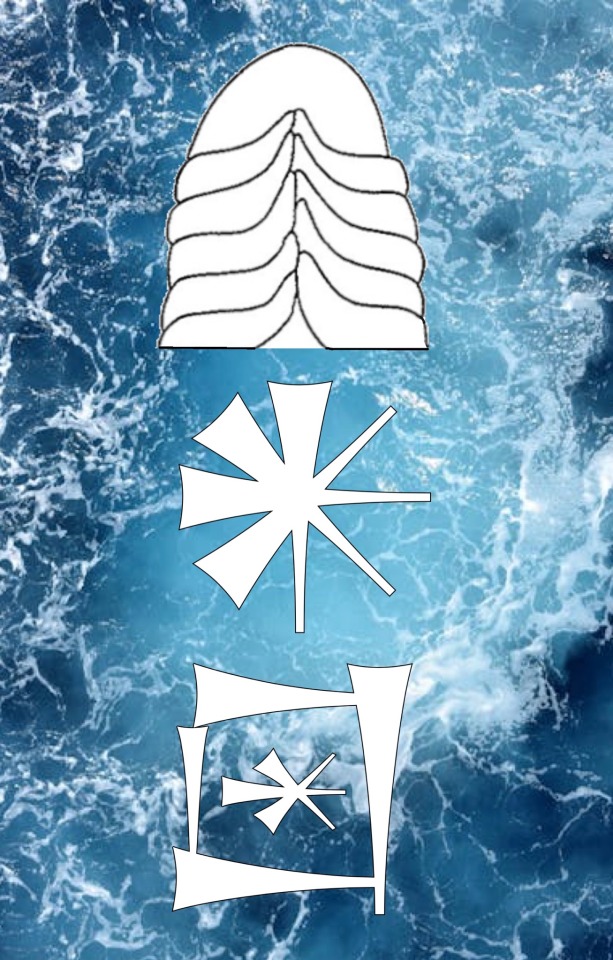

(click on right its not cut off as mobile shows)
#polytheism#paganism#nammu#namma#annunaki#sumerian#sumer#mesopotamia#mesopotamian#eridu#deity#deities#god#goddess#divine#mother goddess#primordial sea#levpag#cuneiform#cuneiform journey#deity resource#landof2rivers
16 notes
·
View notes
Text
The Garden of Eden 🌱 The Real Adam & Eve Story

Official Pyramid Media 369 website: www.pyramidmedia369.com
IG: @Phoenix.Son | @PyramidMedia369
I have often heard others say, "If it's not in the Bible, it's not true". Which is a huge mistake and error of consciousness. This type of blind faith can lead to spiritual deprivation. Liberation and education is our birthright. So, I will provide proof of my claims, as well as break down the certain characters, locations, and events as needed. If you have any questions, send them via email at [email protected].
Why do we know nothing about the Serpent?

The only story we know of the serpent is how it convinced Eve to eat the apple on the forbidden fruit tree. But what's the Serpent's backstory? What relationship did God of the Bible have with the Serpent before Adam and Eve were ever thought of?
There are many creation stories. Some older than others. But the oldest stories seemingly have more evidence and artifacts to support their claims. Like the hieroglyphs in the pyramids for example. They literally are passing down knowledge through drawings, showing us what was really happening. Tablets like what you see below are ages older than the English language itself.
There is lots of information you can find out there about how human DNA was constructed, when it was, where and also who did it. However, there is only one pantheon I have found that has an illustrated story about the creation of human beings. The pantheon I'm referring to are the Annunaki aka Sumerians. The creator of modern day human DNA is Enki.
The eldest Annunaki/Sumerians are the Elohim that traveled here from Nibiru, a planet from the Sirius star system. These are also the Nephillim giants.

Enki - The Serpent God of Sumeria

Enki (EA) was responsible for the creation of the first modern day human. The tablets below show Enki and his son, Ningishzida, grafting the genetic structure of DNA which was used to create Adam. Enki and his counterpart, Ninmah, used this DNA to create Adam with the use of homo-erectus DNA, their own and clay from the Earth; making the first homo-sapiens (us). Earth was home to the homo-erectus before the Annunaki discovered Earth. The first homo-sapiens were heavily melanated. Below you can see that they used the sacred knowledge of the Tree of Life to create human DNA.
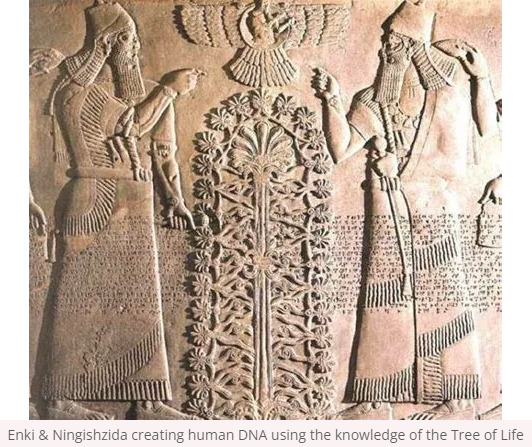
Enki & Ninmah creating Adam
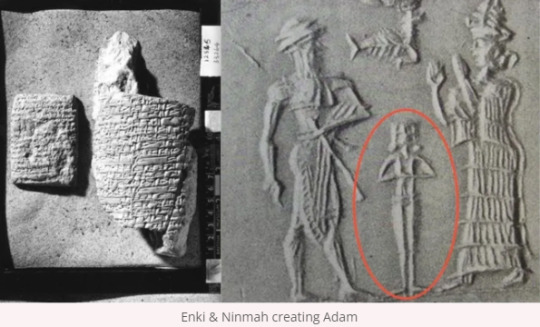
Above you see tablets with the written story vouching for the illustration of Enki and Ninmah creating Adam. Above Adam, you will also see a fish. Enki resides in the ocean below the Earth according to the tablets. This is synonymous to Enki being also the God of Water. Consider the fact that the human body is 70% made of water.
The Q&A below is based on an evaluation of historical facts that are relative to both the Sumerian tablets and the Bible story.
Q: What relationship did the God of the Bible have with the Serpent before Adam and Eve?
A: They're brothers.
Q: Who is Enki's brother?
A: Enlil, The God of Air
Q: How did this become the Bible story?
A: In the Sumerian tablets, Enlil stated, "You shall have no gods before me". This was also stated by God in the Bible, in Exodus 20:3.
Enlil - The Sky God of Sumeria

Enlil (YHVH/JEHOVAH) was the Chief deity on of the Annunaki on Earth, but very known to have a malevolent nature. Tyrannic, jealous and quite violent. He always claimed to be God over all things, due to his father, Anu, leaving Enlil in charge once they discovered Earth from planet Nibiru. Enlil did not support Enki teaching the humans sacred knowledge beyond being a slave-worker. It was Enlil's command that it should not happen. Enki went behind Enlil and secretly instilled in Adam & Eve the ability to procreate, which also gave them Kundalini (the coiling serpent); ultimately giving them self awareness. This is synonymous to the apple that was bitten from the Tree of Life. (Remember, Enki and Ningishzida used the knowledge of the Tree of Life to create Adam & Eve's DNA. Adam & Eve were not the first creations, but the first perfected creations). This self awareness gave Adam & Eve knowledge of Good & Evil. Meaning, both hemisphere's of the torus field (the apple) emanating from the body were now active.
The Torus Field & The Apple

Enlil waged a war on Enki's plans to teach the human beings how to sustain themselves and raise their consciousness through their own self awareness. So Enlil decided to overthrow Enki's creations by killing off as many as he could with the intent to free the humans from bondage. This is how Enlil became the one God. Enlil was appointed as leader of the Annunaki by Enki & Enlil's Father, Anu. Leading to Enlil being labeled as Lord over all. It was Enlil who orchestrated the great flood to kill off the human creations. Enki was not successful in preventing this from happening. With Enlil becoming Lord, the Serpent's role became demonized because it was forbidden by Enlil's command, though Adam & Eve were not his creations. Us humans today, are the remnants and descendants of those that survived this flood.
Enlil created and introduced us to the first weapons on Earth.

It's safe to say that the human creation was an experiment, to say the least. The Serpent only represented wisdom at a point in time. Why do you think this changed?
TO BE CONTINUED...
Check out this article if you would like to learn more about the connection between the Atom and the Flower of Life.
"Ancient Origins of The Flower of Life"
The Tree of Life is the original knowledge of the Flower of Life, which is the knowledge of the Atom, which is the knowledge of Carbon. All of which make up the 666: 6 protons, 6 neutrons, and 6 electrons that make Carbon, which is also Melanin. So this means an Atom is simply a Carbon molecule, which is also a Melanin molecule. Isn't that interesting? Or do you not see the connections? Let me know!
*AS ABOVE, SO BELOW*
Thank you for reading!
Fun Fact: Did you know, that an atom is the only molecule that can occupy two different places at once? There's always more than what meets the eye!
#Ancient#Sumerian#Annunaki#AnnunakiHistory#Enki#Enlil#Ea#Gnostic#Gnosticism#Pyramid#Media#369#PyramidMedia369#Blog#Esoteric#Astrology#Egypt#Adam#Eve#Garden#Of#Eden#GardenOfEden#Mesopotamia#Mankind#Spirituality#Evolution#Earth#Nibiru#Sirius
31 notes
·
View notes
Text
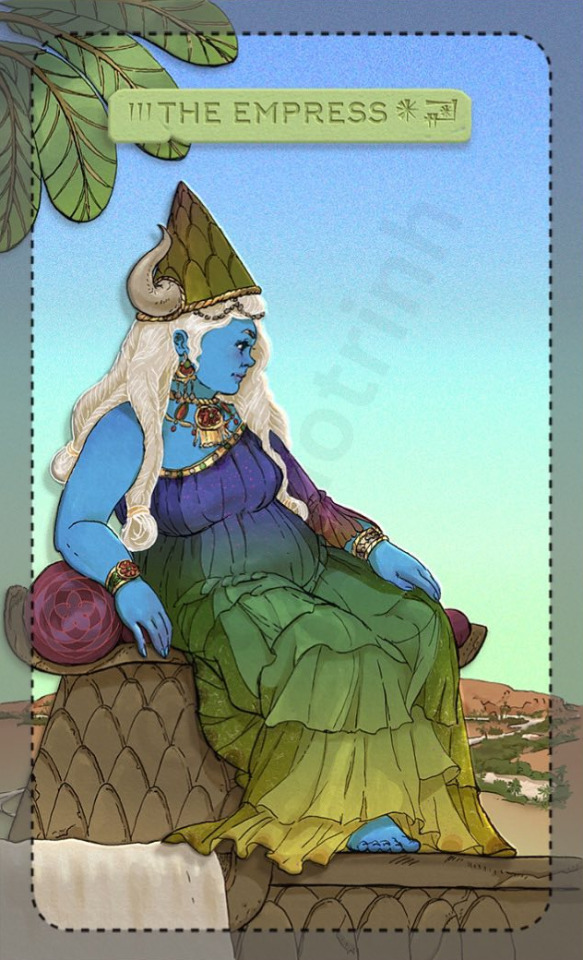
The Empress. Art by Rubi Do Trinh, from the Star of Inanna Tarot.
𒁹𒁹𒁹 The Empress 𒀭𒂼 For this card we decided to depict the Mother Goddess Ki/Ninhursag. Ki is the Earth Mother Goddess ands chief consort of An and Ninhuršag was the Mountain Mother Goddess. According to Samuel Kramer, Ki and Ninhursag are one and the same, and we are inclined to agree. In the Sumerian Creation myth, An and Ki were born of Nammu, the Primordial Mother Goddess. They then came together and Enlil was born. Enlil then separates Ki from An, and they unite. Their union leads to the creation of life on Earth as we know it. Ninhursag has more written about her, but she is also conflated with the Earth and as a Mother Goddess. She has further associations with Mountains and is often depicted with an Omega-like symbol in her hair. Another part of the creation story is found in the myth “Enki and Ninhursag” where they work together to bring abundance, fertility and the possibility of agriculture to the world. She is an essential part of the process of creating humans along with the God Enki. We can see the associations between the archetype of this card and Ki/Ninhursag. Fertility, growth, transformation, creation, pregnancy, childbirth, and nurturing are all aspects that are present in both. However, lesser talked about aspects of this archetype are enforcer of order, & protective yet healing and compassionate. In the Myth “Enki and Ninmah(an epithet)”, when working together to create humans, Enki ends up hurling insults at her creations. In response, she uses her creative powers to punish him, afflicting him with ailments and illnesses only she can heal. She then reveals her compassionate side and ends up healing him. The Cuneiform is: 𒀭 Dingir + 𒂼 ama = Divine Mother
#Rubi Do Trinh#Star of Inanna Tarot#The Empress#Major Arcana#Tarot#Folklore#Sumeria#Inanna#Ki#Ninhursag
12 notes
·
View notes
Text
Personally I don't think Enki would go with the option of killing his twin sister cause it doesn't happen in the Canon either. But I stil wanted to draw it!


Additional frames


#digital art#art#fear and hunger#enki ankarian#fear and hunger enki#my art#firealpaca#funger#fear and hunger animation#animatic#enki ankarian twin#enkistwin#angst#blood and gore#NINMAH
356 notes
·
View notes
Text
Sumerian literature is something else... here are some excerpts:
"An, Enlil, and the lord Nudimmud roasted holy kids."
"Pour ejaculated semen into a woman's womb, and the woman will give birth to the semen of her womb."
"Today let my penis be praised"
3 notes
·
View notes
Text


Enki Enki and Ninhursag Artist: Karmazid Enki saw the man, he did not keep his hands straight, and decreed his fate, and put him in the king’s camp as a servant.
25 notes
·
View notes
Text
Shoutout to a friend of mine (you know who you are 👀) who named Enki’s sister Ninmah and now I get whiplash if I see her being called anything but
#fear and hunger#fear and hunger enki#woes of having to fill the gaps that are in the canon material and forgetting that your fanon is actually unlikely to be in canon#vixx rambles
3 notes
·
View notes